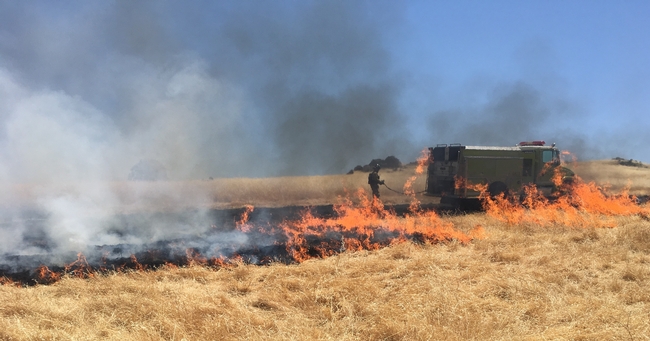Working in partnership with CALFIRE Nevada-Yuba-Placer, sheriff's offices, and offices of emergency services in Placer, Nevada, and Yuba Counties, the livestock community established a 3-county Livestock Access Pass program for commercial livestock producers. While the system was not formally tested in 2021, we have established a systematic approach to helping livestock producers gain safe access to their operations during an emergency. This post summarizes the 2021 efforts and identifies needs and opportunities moving forward.
Steering Committee
The Placer-Nevada-Yuba Livestock Access Pass Program was created by a steering committee comprised of ranchers from all three counties and the Agricultural Commissioners from all three counties, facilitated by UC Cooperative Extension.
Members
Joe Fischer (Placer County Rancher) Roger Ingram (Placer County Rancher)
Laura Barhydt (Nevada County Rancher) Kevin Pharis (Nevada County Rancher)
Carrie Richards (Yuba County Rancher) Justine Dutra (Yuba-Sutter Farm Bureau)
Josh Huntsinger (Placer County Ag Dept) Chris deNijs (Nevada County Ag Dept)
Steven Scheer (Yuba County Ag Dept) Dan Macon (UCCE)
Commercial Livestock Production
The steering committee established the following criteria for determining whether a livestock operation is commercial in nature (for the purposes of the program):
- Qualified Commercial Livestock Operator: For the purposes of this program, a commercial livestock operator is defined as an owner of livestock consisting of 50 head of livestock (including in utero, e.g., 25 bred cows), 100 poultry or rabbits, or 50 beehives or more that reside in Placer, Nevada, or Yuba County for at least a portion of the year, or a person who, through an agreement with that owner of livestock, has authority and is responsible to oversee the care and well-being of the owner's livestock.
- Livestock Species Covered by Program: This program applies to commercially raised species of livestock, including cattle, sheep, goats, hogs, poultry, rabbits, llamas, alpacas, and bees. “Commercially raised” means the livestock are raised as part of a business.
- Application for Registration: To become enrolled in the program, a Commercial Livestock Operator must provide contact information, APNs and/or physical addresses of grazing sites, general season of use, livestock description and count, and other information by completing an online form. Producers without internet access were able to enroll with assistance from UCCE.
Coordination with Other Agencies
The steering committee coordinated with CALFIRE, county sheriff's offices, and county offices of emergency services. Through this coordination, we identified communication needs, a system for integrating the program into the incident command system, and producer training needs.
Producer Training
UCCE and CALFIRE collaborated on organizing an initial four-hour training session in each county. Each session included an overview of the program (UCCE), a discussion about emergency management and the incident command system, a presentation on fire behavior and fire safety (CALFIRE), a presentation on disaster planning at the ranch level (UCCE), and a general discussion about rancher experiences with evacuations and other emergencies. At the conclusion of each training, each producer was photographed for inclusion in their Livestock Access Pass. The Placer County training was held in early August. Due to an increase in wildfires in August and September, the Nevada and Yuba County training sessions were not held until late October.
Producer Demographics
|
|
Placer County |
Nevada County |
Yuba County |
Total |
|
Producers registered |
21 |
41 |
24 |
86 |
|
Producers trained |
11 |
24 |
13 |
48 |
Operation Characteristics (registered producers)
|
Beef Cattle |
Sheep |
Goats |
Swine |
Dairy |
Poultry |
Rabbits |
Bees |
Other |
Average # of Species |
|
56 |
31 |
21 |
15 |
6 |
20 |
2 |
8 |
9 |
2.02 |
|
67% |
37% |
25% |
18% |
7% |
24% |
2% |
10% |
11% |
|
Pass Creation and Distribution
Following each workshop, UCCE staff created an individual, personalized pass for each participant. These were then mailed/delivered to the county agriculture department (in the producer's home county) for signature and sealing. Passes were returned to UCCE and mailed to participants.
Observations and Ideas for 2022
- Given the time it took to develop the program, we were fortunate to complete training sessions in all three counties. Ideally, the training should occur in the late winter or early spring in future years.
- Having Nevada County OES and Sheriff participate in the workshop in Nevada City was outstanding. We will make sure that OES and Sheriff representatives are available for future trainings.
- There are many more producers who we need to reach. We advertised via local cattlemen and farm bureaus, as well as through my newsletter list, but we still missed many producers.
- We'll be offering a 1-hour refresher training for current participants and a 4-hour training for new participants. While tempting to do both virtually, there is definitely value in an in-person interaction with CALFIRE and local agencies.
- Our programs are consistent with the provisions of the new state program created by Assembly Bill 1103 (Dahle). The state program does not necessarily require board of supervisors' endorsement, but we should think about formal presentations in each county.
If you're interested in participating in the Livestock Access Pass program in 2022, contact me at dmacon@ucanr.edu or call (530) 889-7385.
